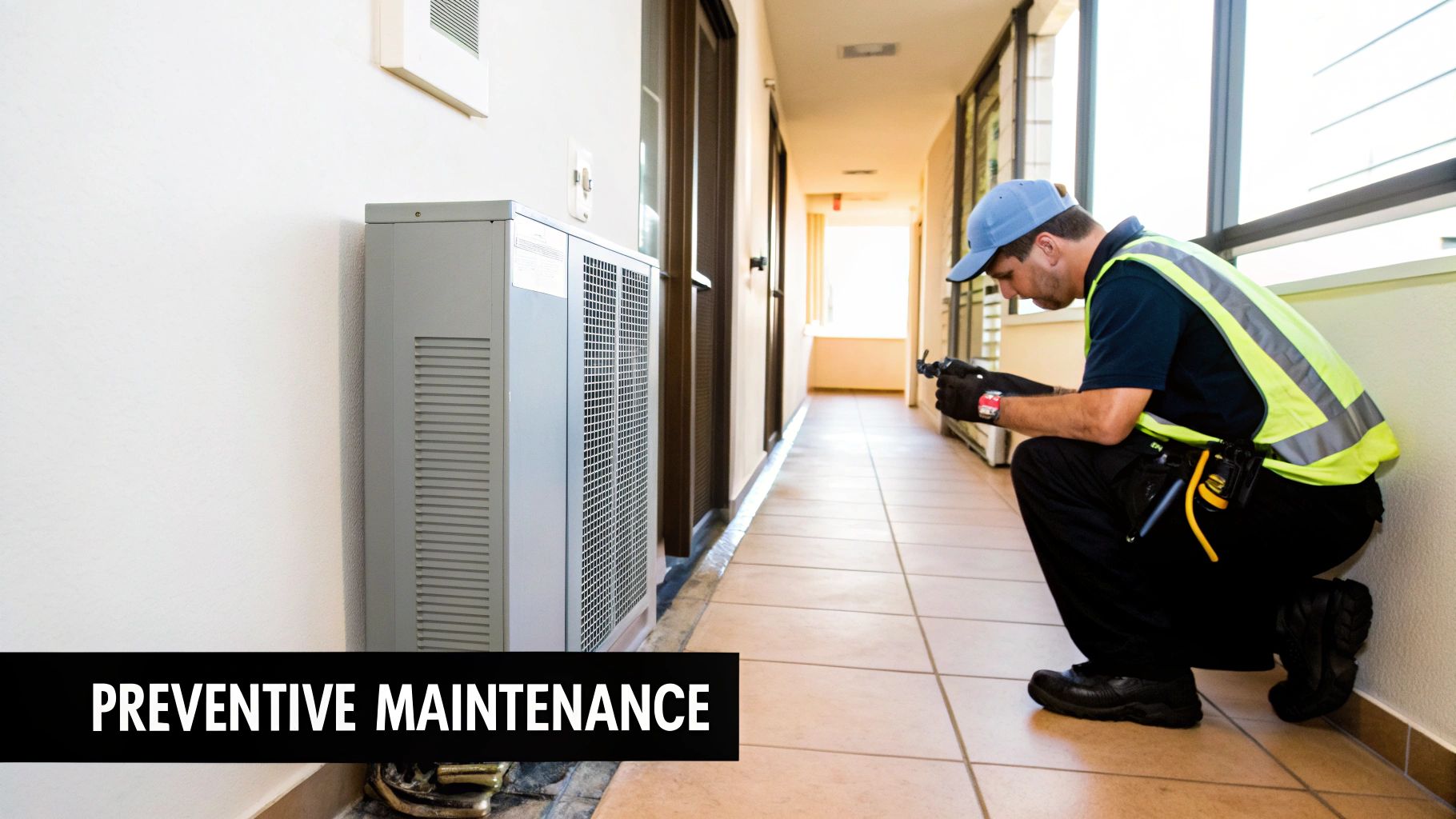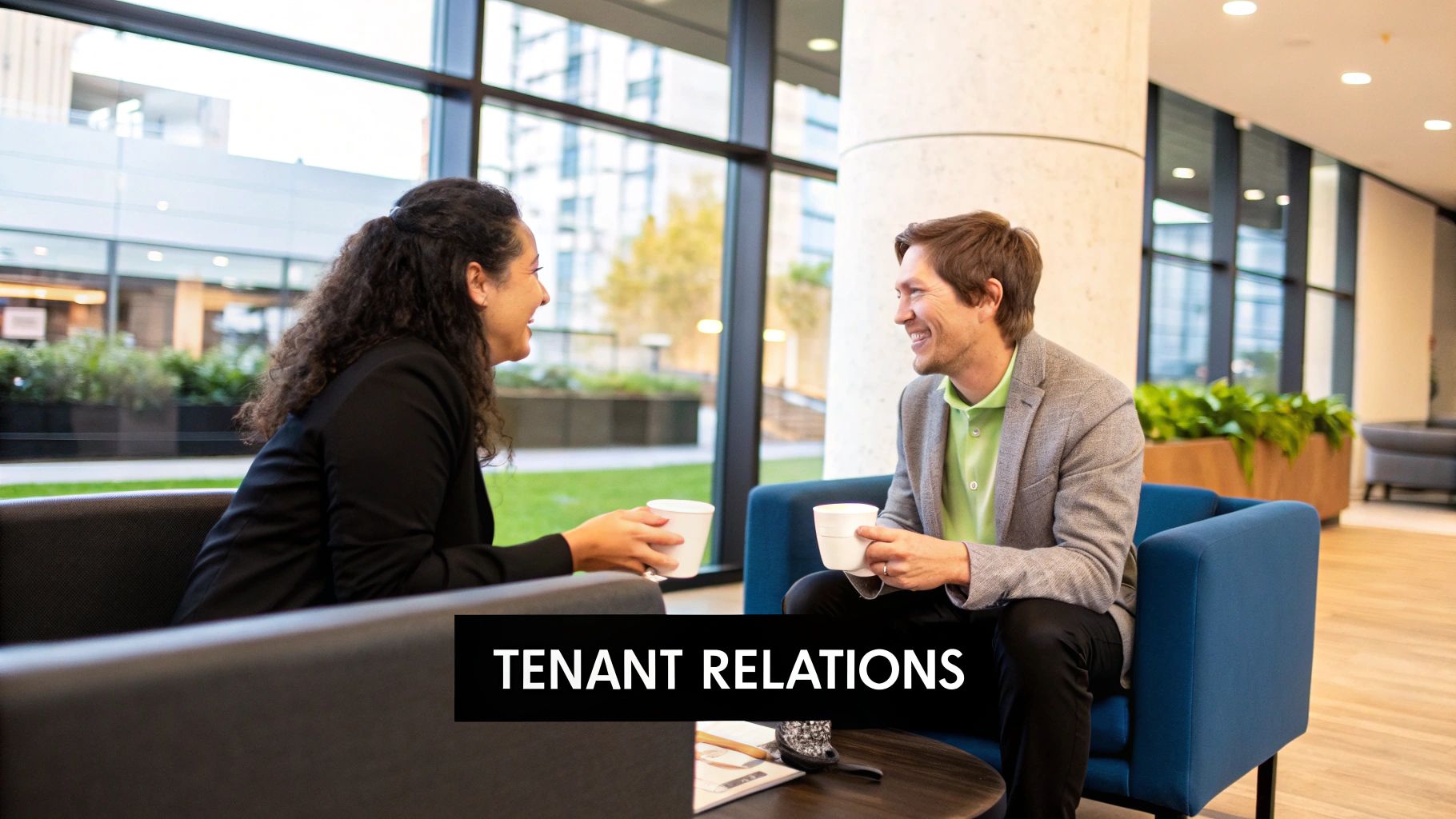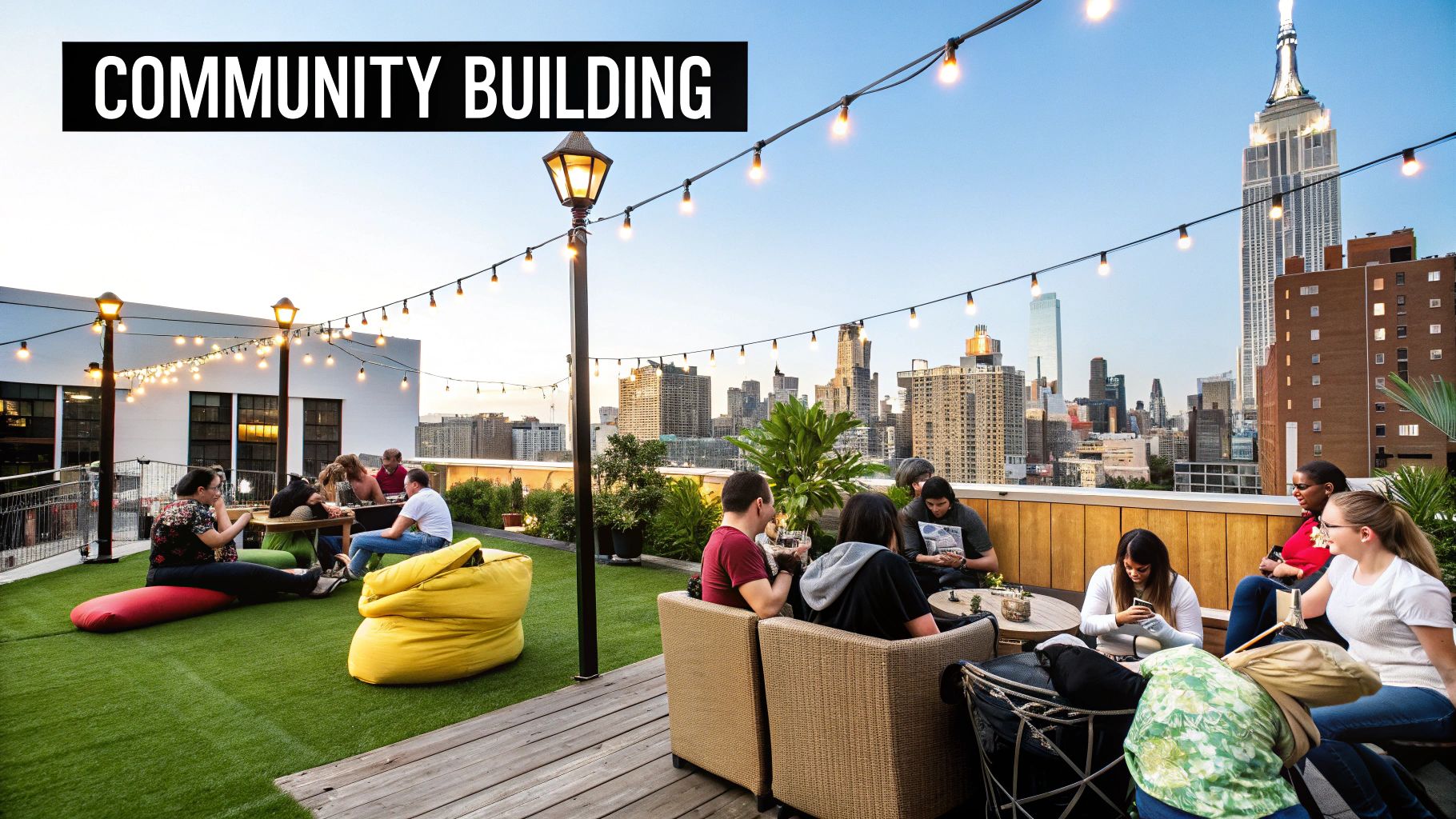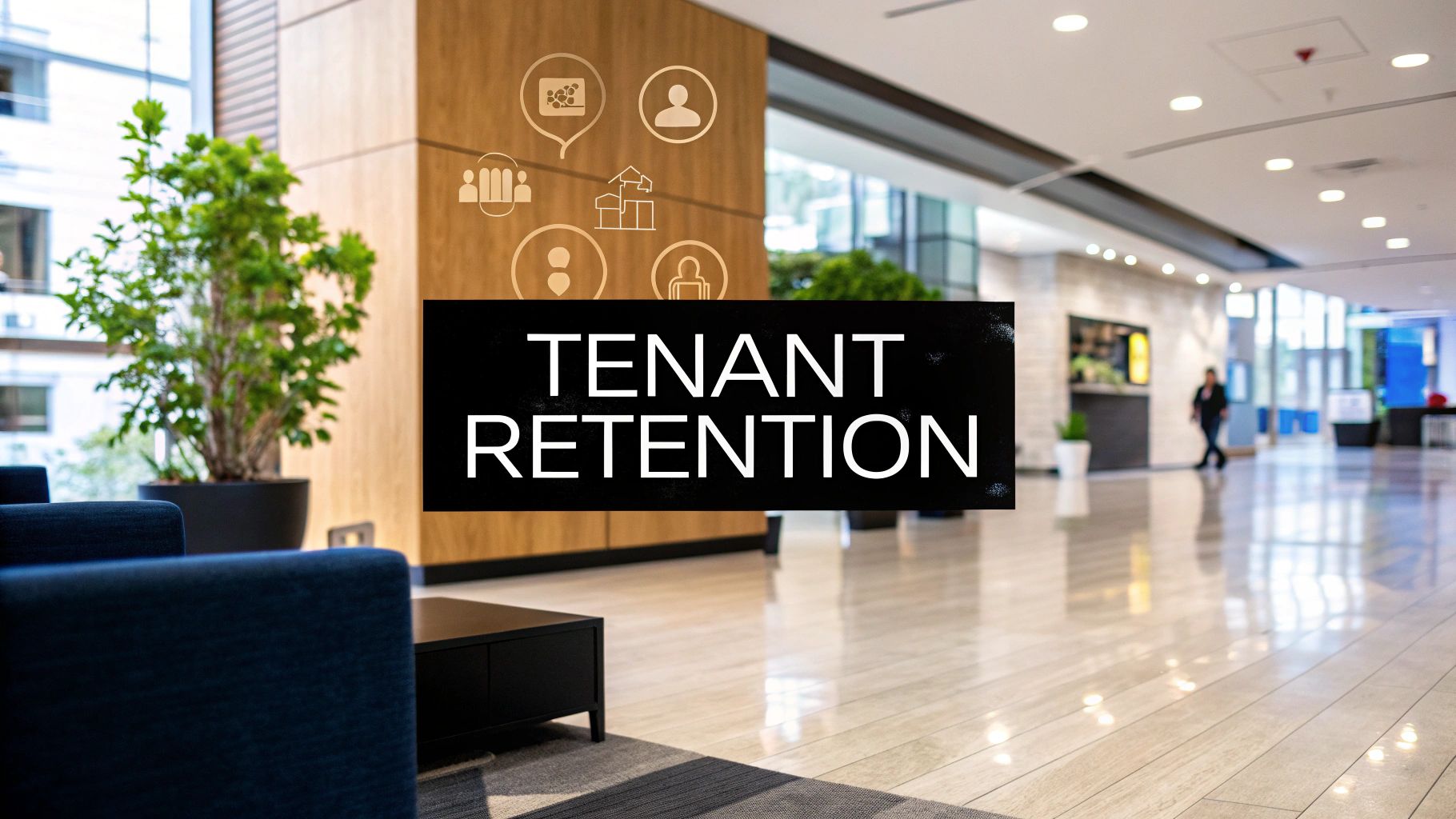In today's competitive multi-family and hospitality markets, attracting tenants is only half the battle. The real key to maximizing net operating income (NOI) and building a stable, thriving community lies in keeping them. High tenant turnover is more than an inconvenience; it is a significant financial drain, encompassing marketing costs, unit preparation, and lost rent during vacancies. Shifting focus from acquisition to retention is a strategic imperative for long-term profitability.
This article moves beyond generic advice to provide a comprehensive roundup of actionable and innovative tenant retention strategies. We will explore how leveraging technology, fostering genuine community, implementing proactive maintenance, and using data-driven insights can transform your properties. The goal is to create an environment tenants are proud to call home, ensuring they stay longer and contribute to a more predictable revenue stream. Many of the principles for building loyalty are universal; to gain further insights into strategies for cultivating lasting relationships across different contexts, explore these effective member retention strategies.
From competitive pricing and flexible lease terms to smart home features and personalized service, this guide offers practical steps for implementation. You will learn to enhance the tenant experience at every touchpoint, turning residents into loyal advocates for your property.
1. Competitive Pricing and Rent Control
A strategic approach to rent pricing is one of the most fundamental yet powerful tenant retention strategies available. This method moves beyond simply charging the maximum the market will bear. It involves setting rental rates that are both competitive within the local market and perceived as fair by current residents, fostering loyalty and reducing costly turnover. The goal is to balance profitability with tenant affordability, creating a stable and predictable financial environment for both parties.

Instead of imposing sudden, dramatic rent hikes at lease renewal, this strategy focuses on modest, predictable increases. This transparency and predictability prevent "sticker shock" that often drives good tenants to seek alternatives.
How to Implement Strategic Pricing
Successful implementation hinges on data, communication, and incentives. Property managers should conduct regular, in-depth market analyses to understand competitor pricing, vacancy rates, and local economic trends. This data provides the foundation for setting a base rent that reflects the property's value without alienating the existing tenant base.
Major operators have pioneered this approach with great success. For instance, AvalonBay Communities often implements planned annual rent increases of 3-5% rather than sudden, market-rate jumps. Similarly, Greystar frequently offers lease renewal bonuses and attractive rate locks for tenants willing to sign multi-year commitments, providing them with security and the company with guaranteed occupancy.
Actionable Tips for Fair Pricing
To effectively use pricing as a retention tool, consider these specific actions:
- Conduct Quarterly Market Analysis: Regularly benchmark your rates against comparable properties to ensure you remain competitive but fair.
- Offer Early Renewal Incentives: Provide a small discount or a fixed rate for tenants who renew their lease 60-90 days before expiration.
- Communicate Transparently: When an increase is necessary, provide tenants with ample notice (90 days is best practice) and a clear, concise justification based on rising operational costs, property improvements, or market data.
- Reward Loyalty: Factor a tenant's payment history and length of tenancy into renewal pricing. Consider offering long-term residents a graduated increase schedule that is below the market rate for new leases.
2. Proactive Property Maintenance and Upgrades
A proactive approach to property maintenance is a cornerstone of effective tenant retention strategies. This method shifts the focus from reactive repairs to preventive care and consistent upgrades, ensuring the property remains in excellent condition. By addressing potential issues before they become major problems and demonstrating a commitment to quality, property managers enhance resident satisfaction, justify rental rates, and build a reputation for reliability.

This strategy involves scheduled inspections, regular servicing of systems like HVAC and plumbing, and a long-term plan for capital improvements. A well-maintained property not only prevents inconvenient breakdowns but also shows tenants that their comfort and safety are a top priority.
How to Implement Proactive Maintenance
Successful implementation requires a structured system for scheduling, tracking, and communication. Property managers must create detailed maintenance calendars for all common areas and in-unit systems. A modern work order management system is crucial for logging requests, prioritizing tasks, and ensuring timely completion.
Leading operators exemplify this approach. For example, Lincoln Property Company leverages IoT sensors to monitor HVAC systems for potential failures, allowing for preventive action. Similarly, BH Management is known for its quarterly unit inspections and comprehensive preventive schedules, while Pinnacle Property Management Services often guarantees same-day response for urgent maintenance requests, setting a high standard for service.
Actionable Tips for Excellent Maintenance
To transform maintenance from a cost center into a powerful retention tool, consider these actions:
- Create Detailed Maintenance Schedules: Develop and follow a calendar for routine checks on all building systems, from fire safety equipment to elevators and boilers.
- Invest in Quality Materials: Use durable, high-quality fixtures and materials during repairs and upgrades to reduce the frequency of future maintenance needs.
- Train Staff on Customer Service: Ensure maintenance technicians are trained not only in their technical skills but also in professional communication and customer service.
- Conduct Annual Satisfaction Surveys: Survey tenants specifically about property condition and maintenance responsiveness to identify areas for improvement.
3. Enhanced Communication and Tenant Relations
A relationship-focused strategy is one of the most effective tenant retention strategies for fostering loyalty and reducing churn. This approach moves beyond transactional interactions by prioritizing open, consistent, and multi-channel communication. It treats tenants as valued customers, not just occupants, building strong landlord-tenant relationships through regular check-ins, proactive feedback systems, and community-focused initiatives.

When tenants feel heard, respected, and connected to their community, they are far more likely to renew their leases. This proactive engagement transforms the living experience from a simple rental agreement into a positive, supportive community environment.
How to Implement Enhanced Communication
Successful implementation requires a commitment to consistency and responsiveness across multiple channels. This means establishing a clear communication protocol that makes it easy for tenants to reach management and receive timely, helpful replies. Technology platforms like tenant portals and community apps are crucial for streamlining these interactions.
Leading operators demonstrate the power of this approach. JVM Realty, for example, hosts quarterly tenant appreciation events and feedback sessions to build rapport and gather insights directly from residents. Similarly, platforms like RentSpree facilitate community apps that centralize communication, event notifications, and service requests, making engagement seamless for both tenants and staff. This strategy is heavily endorsed by organizations like the National Association of Residential Property Managers (NARPM).
Actionable Tips for Better Relations
To effectively use communication as a retention tool, consider these specific actions:
- Establish a Communication Schedule: Implement a regular cadence for communication, such as monthly e-newsletters or quarterly check-ins, and stick to it.
- Leverage Tenant Portals: Use a dedicated portal or app for streamlined communication, maintenance requests, and community announcements to keep everything organized and accessible.
- Commit to a 24-Hour Response Time: Ensure all tenant inquiries, regardless of the channel, receive a response within one business day to show you value their time.
- Create Community Newsletters: Regularly share property updates, local events, and resident spotlights to foster a sense of community and keep everyone informed.
- Invest in Staff Training: Equip your team with customer service and conflict resolution skills to handle tenant interactions professionally and empathetically.
4. Flexible Lease Terms and Renewal Incentives
A tenant-centric approach to leasing that moves beyond the standard 12-month contract is a powerful tenant retention strategy. This method involves offering customized lease options, attractive renewal bonuses, and flexible terms that accommodate the evolving needs of residents. It acknowledges that a one-size-fits-all structure is outdated and instead fosters loyalty by providing options that create mutually beneficial, long-term arrangements.

By providing agility in lease agreements, property managers can adapt to tenants' life changes, such as job relocations or changing family sizes, making it easier for them to stay within the property portfolio rather than leaving altogether.
How to Implement Flexible Leasing
Successful implementation requires a proactive and adaptable leasing framework. Instead of a rigid annual cycle, operators can offer a menu of options at both the initial signing and the renewal stage. This means having clear, pre-defined policies for different lease lengths, modification requests, and early termination scenarios to ensure consistency and fairness.
Leading operators have integrated this flexibility into their core business models. For example, UDR offers a variety of lease terms including 6, 9, 12, and 15-month options, giving tenants the power to choose what best fits their life plans. Similarly, Bozzuto is known for offering compelling renewal incentives, such as significant rent credits for residents who commit to a two-year lease, directly rewarding their loyalty and securing long-term occupancy.
Actionable Tips for Flexible Leasing
To effectively use lease flexibility and incentives as a retention tool, consider these specific actions:
- Offer Renewal Incentives Early: Present renewal options and any associated bonuses, like a gift card or a small rent credit, 60-90 days before the lease expires.
- Create Clear Modification Policies: Develop and transparently communicate a straightforward process for tenants who may need to add a roommate, transfer to a different unit, or break their lease due to a major life event.
- Use Technology to Manage Terms: Implement property management software to efficiently track varied lease expiration dates, automate renewal offers, and manage different pricing structures.
- Benchmark Incentive Costs: Regularly analyze the cost of incentives (e.g., one month's free rent) against the high expenses of tenant turnover, including marketing, vacancy loss, and unit preparation.
5. Technology Integration and Smart Home Features
Integrating technology and smart home features is a forward-thinking tenant retention strategy that directly enhances the modern living experience. This approach goes beyond basic amenities by offering convenience, security, and efficiency through connected devices. By embedding technology into the property, operators can create a premium environment that appeals to tech-savvy residents and justifies higher rental values, significantly boosting tenant satisfaction and loyalty.
From smart thermostats that lower utility bills to keyless entry systems that add convenience, these features transform a standard apartment into a modern, responsive home. This technological edge becomes a powerful differentiator in a competitive rental market, making tenants less likely to leave for a less-equipped property.
How to Implement Smart Technology
A successful smart home strategy begins with foundational features and scales based on resident needs and property infrastructure. The key is to select technologies that provide tangible daily benefits and integrate seamlessly into a centralized management system or resident app. This unified experience prevents technological fragmentation and enhances usability.
Leading operators have set the standard for this approach. Related Companies, for instance, provides residents with a custom building app to control smart home devices, book amenities, and communicate with management. Likewise, AvalonBay Communities has made smart features like thermostats and locks a brand standard, recognizing them as essential components of their value proposition. For more insights, you can learn more about IoT's role in property management.
Actionable Tips for Technology Integration
To effectively deploy technology as a retention tool, consider these practical steps:
- Start with High-Impact Basics: Begin with universally valued features like smart thermostats, keyless entry, and smart lighting before investing in more complex systems.
- Prioritize Seamless Integration: Choose a technology platform that unifies device control, maintenance requests, and community communication into a single, user-friendly resident app.
- Provide Robust Support: Offer clear instructions, tutorials, and responsive tech support to help residents maximize the benefits of their smart home features.
- Focus on Tangible Benefits: Beyond convenience, you can explore VPP benefits like blackout protection to ensure essential services remain active during outages, a powerful and practical selling point.
- Gather Feedback for Future Upgrades: Regularly survey tenants to understand which technologies they value most and use that data to guide future investments and upgrades.
6. Community Building and Amenity Enhancement
A holistic strategy that focuses on creating a true sense of belonging is one of the most powerful tenant retention strategies. This approach moves beyond providing basic housing to cultivate a vibrant community through thoughtfully designed amenities, regular social events, and engaging shared spaces. The goal is to transform a property into a lifestyle destination where tenants form meaningful connections, making them far less likely to leave.
By fostering an environment where residents know their neighbors and feel invested in the property's social fabric, operators can build powerful loyalty that transcends price. This transforms a lease into a membership in an exclusive, desirable community.
How to Implement Community and Amenity Programs
Successful implementation requires a proactive and tenant-centric approach. It starts with understanding resident demographics and preferences to tailor amenities and programming accordingly. This means moving beyond generic offerings and creating experiences that resonate with the specific lifestyle of the tenant base, whether they are young professionals, families, or active adults.
Leading operators have mastered this art. For example, The Irvine Company is renowned for developing resort-style amenities including elaborate pools, spas, and outdoor kitchens that serve as social hubs. Likewise, Essex Property Trust actively boosts engagement by hosting events like monthly wine tastings and group fitness classes, while Post Properties pioneered developing on-site co-working spaces and business centers to cater to the rise of remote work.
Actionable Tips for Building Community
To effectively use community and amenities as a retention tool, consider these specific actions:
- Survey Tenants Regularly: Actively solicit feedback on desired amenities, events, and social programming to ensure investments align with resident wants.
- Create Diverse Programming: Plan a varied calendar of events that appeals to different interests and age groups, such as cooking classes, holiday parties, book clubs, and kid-friendly activities.
- Partner with Local Businesses: Forge partnerships to offer residents exclusive discounts or on-site services like dry cleaning pickup, dog walking, or food truck nights.
- Leverage Social Media: Create private resident groups on platforms like Facebook to promote events, share community news, and facilitate organic resident interaction.
7. Personalized Tenant Experience and Customer Service
Adopting a hospitality-centric mindset is a transformative tenant retention strategy that shifts the dynamic from a simple landlord-tenant transaction to a valued customer relationship. This approach involves treating each resident as an individual with unique needs, remembering personal preferences, and delivering customized service. By making tenants feel genuinely seen and valued, property managers can foster deep loyalty that transcends price and location.
This strategy moves beyond reactive problem-solving to proactive, personalized engagement. It means knowing a resident's pet's name, acknowledging their birthday, or offering a lease renewal package tailored to their specific lifestyle, creating an environment where residents feel they belong.
How to Implement Personalized Service
Successfully creating a personalized experience requires a combination of technology and a well-trained, empathetic team. A robust CRM system is essential for tracking interactions, maintenance requests, personal preferences, and important dates. This data empowers staff to deliver consistently high-touch service that anticipates needs rather than just responding to issues.
Major operators have mastered this art. For example, Gables Residential is known for maintaining detailed tenant preference files to personalize everything from communication to service responses. Similarly, Camden Property Trust elevates the resident experience with dedicated concierge services and customized lease renewal offers, while ZRS Management builds loyalty through personalized rewards programs. This focus on individual recognition is a cornerstone of their high retention rates.
Actionable Tips for a Personalized Experience
To effectively implement this high-touch service model, consider these actions:
- Utilize a CRM System: Track every interaction, preference (e.g., communication style, maintenance notes), and key date (e.g., lease anniversary, birthday) for each resident.
- Invest in Hospitality Training: Train all staff, from leasing agents to maintenance technicians, on customer service excellence, including using tenants' names and remembering personal details.
- Create Personalized Touchpoints: Acknowledge milestones like birthdays or move-in anniversaries with a small, thoughtful gesture. Personalize renewal offers based on a tenant's history and needs.
- Leverage Smart Technology: Implementing smart apartment technology allows residents to customize their living environment, from climate to security, adding a powerful layer of personalization to their daily experience.
8. Data-Driven Tenant Analytics and Predictive Retention
Leveraging data analytics is a sophisticated tenant retention strategy that transforms resident information into actionable insights. This approach moves beyond reactive problem-solving by using machine learning and predictive modeling to identify tenants who are at risk of non-renewal. By analyzing patterns in payment history, maintenance requests, and communication frequency, property managers can proactively address potential issues before they lead to a resident leaving.
The core goal is to predict churn likelihood and trigger targeted interventions. For example, if a model identifies that a sudden increase in maintenance requests combined with late rent payments often precedes non-renewal, management can be automatically alerted to engage with that specific resident.
How to Implement Predictive Retention
Successful implementation requires integrating data from various sources into a centralized system. Property management software can track key metrics, which are then fed into an analytics platform to generate retention scores or risk profiles for each tenant. This data-driven approach allows for personalized and timely outreach.
Industry leaders are already demonstrating the power of this method. Greystar utilizes predictive analytics to forecast lease renewal likelihood, allowing its teams to focus retention efforts where they will be most effective. Likewise, platforms like RealPage and Yardi offer integrated analytics that provide tenant retention scoring and automated intervention triggers, helping operators make informed, proactive decisions.
Actionable Tips for Data-Driven Analytics
To effectively use analytics as one of your core tenant retention strategies, consider these actions:
- Start with Basic Tracking: Begin by consistently tracking key behaviors like on-time payments, work order frequency, and community event attendance before moving to advanced models.
- Ensure Data Privacy: Be transparent with residents about what data you collect and how it is used, ensuring full compliance with privacy regulations like GDPR or CCPA.
- Combine Insights with Human Touch: Use data to flag potential issues, but rely on well-trained staff to build genuine relationships and address concerns with empathy.
- Test and Refine Models: Regularly validate your predictive models against actual renewal outcomes to improve their accuracy and effectiveness over time.
Tenant Retention Strategies Comparison Table
| Strategy | Implementation Complexity 🔄 | Resource Requirements ⚡ | Expected Outcomes 📊 | Ideal Use Cases 💡 | Key Advantages ⭐ |
|---|---|---|---|---|---|
| Competitive Pricing and Rent Control | Medium: ongoing market research and analysis | Moderate: staff for market tracking | Stable cash flow, reduced turnover | Properties in stable or slowly appreciating markets | Predictable revenue, tenant trust, lower vacancy |
| Proactive Property Maintenance and Upgrades | High: scheduling, tracking, and rapid response | High: maintenance staff, tools, contractors | Higher tenant satisfaction, fewer emergencies | Properties needing upkeep and long-term value maintenance | Prevents costly repairs, improves property value |
| Enhanced Communication and Tenant Relations | Medium: multi-channel systems and dedicated staff | Moderate: communication platforms and staff | Strong tenant loyalty, early issue resolution | Large portfolios focused on tenant engagement | Builds community, improves lease compliance |
| Flexible Lease Terms and Renewal Incentives | Medium-High: lease customization and tracking | Moderate: lease management systems | Reduced vacancy, improved tenant satisfaction | Markets with diverse tenant needs or seasonal demand | Competitive edge, tenant goodwill |
| Technology Integration and Smart Home Features | High: tech installation and system integration | High: upfront tech costs and maintenance | Enhanced tenant experience, operational efficiency | Modern, tech-forward properties targeting younger tenants | Differentiation, automation, operational savings |
| Community Building and Amenity Enhancement | High: event planning and amenity management | High: staff and ongoing programming costs | Tenant emotional attachment, premium pricing | Lifestyle-focused properties aiming for long-term retention | Positive word-of-mouth, social tenant bonds |
| Personalized Tenant Experience and Customer Service | High: data management and skilled staff | High: CRM systems, customer service training | Exceptional loyalty, premium pricing opportunities | High-end or boutique properties prioritizing service | Strong referrals, reduced complaints |
| Data-Driven Tenant Analytics and Predictive Retention | Very High: advanced analytics and data systems | Very High: tech investment and staff training | Proactive retention, optimized resource use | Large portfolios using PropTech for decision support | Scalable personalized retention, objective insights |
Building a Retention-Focused Future for Your Properties
Moving beyond a transactional landlord-tenant relationship is the definitive path to long-term success in today's competitive rental market. The strategies detailed in this guide are not isolated tactics but interconnected components of a holistic, tenant-centric ecosystem. Mastering these approaches transforms your properties from mere living spaces into vibrant, supportive communities where residents feel valued and understood.
Effective tenant retention strategies are fundamentally about creating a superior living experience. This means shifting from a reactive mindset, where you fix problems as they arise, to a proactive one, where you anticipate needs and consistently exceed expectations. It's the difference between simply offering a place to live and cultivating a place residents are proud to call home. This commitment fosters loyalty that goes far beyond a signed lease agreement.
Synthesizing Your Retention Strategy
As we've explored, a powerful retention framework rests on several key pillars. Let's recap the essential takeaways:
- Financial & Operational Excellence: Competitive pricing, transparent communication, and flexible lease terms create a foundation of trust and fairness. Proactive maintenance protocols not only prevent costly repairs but also demonstrate a tangible commitment to resident well-being.
- Experience & Community: Technology integration, from smart home features to a streamlined resident portal, adds modern convenience. Simultaneously, curated community events and enhanced amenities build social connections, transforming neighbors into a cohesive community.
- Personalization & Insight: Exceptional customer service and a personalized approach make residents feel seen and heard. Leveraging data-driven analytics allows you to move from guessing what tenants want to knowing what they need, enabling you to make informed decisions that directly impact satisfaction.
Putting Your Retention Plan into Action
The ultimate goal is to create a virtuous cycle: a superior living experience leads to higher tenant satisfaction, which in turn drives longer tenures, positive online reviews, and valuable resident referrals. This cycle not only reduces the high costs associated with turnover, such as marketing expenses, vacancy losses, and unit preparation, but it also elevates your brand reputation. A property known for its excellent management and happy residents naturally attracts higher-quality, long-term tenants.
Begin by identifying one or two key areas for improvement. Perhaps it's launching a new communication platform or scheduling a community-wide social event. Start small, measure the impact, and build momentum. The most successful tenant retention strategies are not implemented overnight; they are woven into the very fabric of your property's daily operations, creating a culture of excellence that residents can feel from the moment they move in.
Ready to build the technological foundation for your retention strategy? Clouddle Inc specializes in deploying and managing the essential smart security, networking, and cloud services that power a modern, connected residential experience. Visit Clouddle Inc to learn how our managed technology solutions can help you implement key strategies, enhance resident satisfaction, and secure your property’s future.


